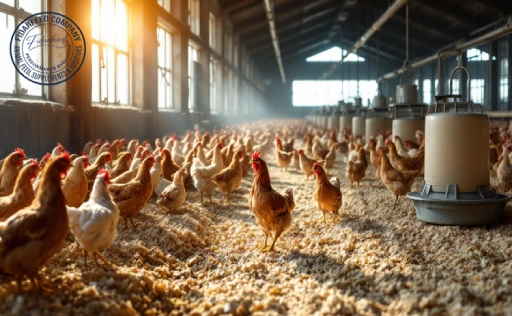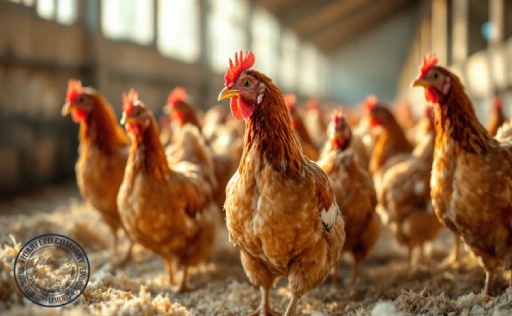Sudden dietary changes can significantly impact broiler performance, affecting growth rates, feed efficiency, and overall health. For broiler breeders, nutrition consistency is crucial, but sometimes shifts in diet become unavoidable. Whether due to ingredient shortages, cost fluctuations, or formulation errors, abrupt dietary changes can lead to serious consequences. Understanding these effects and implementing strategic solutions can help maintain steady growth and productivity. Read on to explore the causes, effects, and best practices for managing diet transitions effectively.
What Are Sudden Dietary Changes in Broilers?
A sudden dietary change occurs when broilers experience an unexpected shift in their feed composition, texture, or nutrient balance. Unlike gradual feed transitions, where adjustments are made over several days, sudden changes expose birds to a completely different nutritional profile without time for adaptation. This can happen due to feed supply issues, ingredient substitutions, or reformulated rations.
Learn more about: Active Probiotic Yeast for Poultry
Broilers have sensitive digestive systems that rely on consistency. Any abrupt change disrupts their gut microbiota, impacting nutrient absorption and digestion. Therefore, even a minor modification in protein levels, energy sources, or fiber content can cause noticeable performance drops.
How Do Sudden Dietary Changes Affect Broiler Performance?
When broilers face an unexpected diet shift, their performance can decline in several ways:
- Reduced Feed Intake: Birds may refuse to eat unfamiliar feed, leading to lower energy intake and poor growth.
- Digestive Distress: Changes in fiber or protein content can cause diarrhea, pasty vents, or unformed droppings.
Learn more about: Meat Meal vs. Soybean Meal: Unlocking Superior Nutritional Benefits for Broiler Chicks
- Fluctuations in Feed Conversion Ratio (FCR): A disrupted gut microbiome affects digestion efficiency, increasing feed costs per kilogram of weight gain.
- Weakened Immunity: Poor nutrition balance can make broilers more susceptible to diseases like necrotic enteritis and coccidiosis.
Common Causes of Sudden Dietary Changes in Broilers
Several factors contribute to unexpected feed modifications, including:
Ingredient Shortages: Seasonal crop availability and market fluctuations force feed mills to substitute raw materials.
Price Volatility: Rising costs of key ingredients like corn, soybean meal, or fishmeal often lead to reformulated diets.
Learn more about: ChikaChika: Benefits of Raising Campine Chickens
Formulation Errors: Mistakes in feed mixing or incorrect nutritional calculations can alter diet composition overnight.
Feed Contamination: Mold growth, rancid fats, or mycotoxin contamination may necessitate an emergency change in rations.
Logistical Issues: Delayed shipments or supply chain disruptions can force farmers to switch to alternative feeds suddenly.
Signs That Your Broilers Are Struggling with a Sudden Diet Change
Identifying early warning signs helps prevent prolonged performance dips. Watch for these indicators:
- Decreased Appetite: Birds showing reluctance to eat the new feed.
- Unusual Droppings: Loose or foamy feces signaling digestive distress.
Learn more about: Guide to Choosing the Best Broiler Breed: Cobb 700 vs Cobb 500
- Reduced Growth Rates: Slower weight gain and uneven flock sizes.
- Behavioral Changes: Increased pecking, lethargy, or signs of stress.
- Increased Mortality: Higher death rates due to nutrient deficiencies or digestive complications.
The Hidden Risks: Health and Economic Impact on Broiler Farms
Beyond immediate performance drops, sudden dietary shifts pose serious risks to flock health and farm profitability. Broilers unable to digest new feed efficiently may suffer from intestinal disorders, leading to secondary infections. Poor nutrition also affects meat quality, reducing carcass yield and consumer appeal.
Learn more about: Mastering the Basics: A Comprehensive Broiler Breeder Management Guide
Economically, inconsistent feed efficiency increases production costs. A higher FCR means more feed is required for the same weight gain, cutting into profit margins. Additionally, mortality spikes or disease outbreaks result in veterinary expenses and financial losses for farmers.
Best Practices to Prevent Performance Drops Due to Dietary Changes
Preventing sudden feed transitions is key to maintaining broiler health and productivity. Here’s how to minimize risks:
- Gradual Feed Transition: Blend new feed with the old diet over 5-7 days to help birds adapt.
- Nutritional Consistency: Work with a qualified nutritionist to ensure alternative formulations meet the same energy and protein requirements.
- Ingredient Quality Control: Always test new ingredients for contaminants or mycotoxins before use.
- Record Keeping: Maintain detailed feed logs to track changes and their impact on performance.
What to Do If Broilers React Poorly to a New Diet?
If your broilers show signs of distress after a sudden diet change, take immediate corrective actions:
- Reintroduce Old Feed: If possible, mix some of the previous feed to ease the transition.
- Supplement with Probiotics: Gut health boosters like probiotics or organic acids can support digestion.
- Optimize Water Quality: Ensure birds have clean, fresh water to support nutrient absorption.
- Adjust Feeding Schedules: Smaller, more frequent feedings can help broilers adjust gradually.
Learn more about: Broiler Chicken Health at Risk? Know the Signs of Dysentery
Expert Tips for Optimizing Broiler Diet Transitions
To maintain peak broiler performance, consider these expert recommendations:
- Use Feed Enzymes: Enzymes like phytase and protease enhance nutrient digestibility, especially during diet changes.
- Monitor Weight Gain Closely: Track growth patterns to identify potential nutrient deficiencies early.
- Communicate with Feed Suppliers: Stay informed about possible ingredient substitutions in advance to plan smooth transitions.
- Train Farm Workers: Educate staff on recognizing early signs of dietary stress and proper intervention strategies.
Learn more about: how to breed broiler chickens
Conclusion: Ensuring Steady Growth and Performance in Your Broilers
Sudden dietary changes are sometimes unavoidable, but their negative impact on broiler performance can be minimized with the right strategies. By understanding the risks, closely monitoring flock health, and implementing gradual feed transitions, broiler breeders can safeguard growth rates and profitability. Have you experienced challenges with diet changes in your flock? Share your thoughts and experiences in the comments below!







